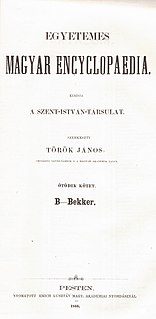 W
WA Franklin kézi lexikona a larger handbook in Hungarian published at the beginning of the 20th century.
 W
WA Pallas nagy lexikona was the first Hungarian encyclopedia which was not a translation from other languages. It was published by the Pallas Literary and Press Corporation between 1893 and 1897. The encyclopedia comprised 16 volumes, 150 000 articles, and it was the work of 300 authors.
 W
WAz Athenaeum kézi lexikona, in English: Handbook of the Athenaeum, subtitled The Encyclopaedia of Science with Special Reference to Hungary was a large 2-volume general lexicon in Hungarian at the end of 19th century.
 W
WThe Hungarian Wikipedia is the Hungarian/Magyar version of Wikipedia, the free encyclopedia. Started on July 8, 2003, this version reached the 300,000 article milestone in May 2015. As of 21 November 2020 this edition has 478,728 articles and is the 26th largest Wikipedia edition.
 W
WThe Life and works of Hungarian writers is a lexicon of Hungarian literature written at the turn of the century by József Szinnyei. The 14-volume work, published between 1891 and 1914, sought to bring together all those who had published a literary work published in their hands. The life and work of Hungarian writers is still a masterpiece and one of the greatest simple literary works.
 W
WOrbis Pictus, or Orbis Sensualium Pictus, is a textbook for children written by Czech educator John Amos Comenius and published in 1658. It was the first widely used children's textbook with pictures, published first in Latin and German and later republished in many European languages. The revolutionary book quickly spread around Europe and became the defining children's textbook for centuries.
 W
WThe Life of the Saints of Zalka – Zsihovics – Debreczeni is a large-scale 19th century hagiographic work.
 W
WThe Universal Hungarian Encyclopaedia is a 13-volume Hungarian lexicon published in the second half of the 19th century.
 W
WThe World lexicon of Tolnai, after a long preparatory work, was first published in 1912, when only 8 volumes were published. The publication of additional volumes that had already been prepared was prevented by the First World War, largely rendering obsolete the contents of the published and still edited volumes of the series.